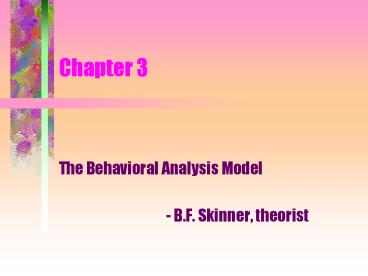The Behavioral Analysis Model - PowerPoint PPT Presentation
1 / 51
Title:
The Behavioral Analysis Model
Description:
Extinction is stopping all reinforcement that has been maintaining an inappropriate behavior. ... Negative Practice-Stimuli Satiation is having the student repeat the ... – PowerPoint PPT presentation
Number of Views:45
Avg rating:3.0/5.0
Title: The Behavioral Analysis Model
1
Chapter 3
- The Behavioral Analysis Model
- - B.F. Skinner, theorist
2
(No Transcript)
3
Decreasing Misbehavior
4
Decreasing Misbehavior
- Extinction
5
Decreasing Misbehavior
- Extinction
- Differential Reinforcement
6
Decreasing Misbehavior
- Extinction
- Differential Reinforcement
- Response-Cost Procedure
7
Decreasing Misbehavior
- Extinction
- Differential Reinforcement
- Response-Cost Procedure
- Time-Out
8
Decreasing Misbehavior
- Extinction
- Differential Reinforcement
- Response-Cost Procedure
- Time-Out
- Aversive Stimuli
9
(No Transcript)
10
Extinction
11
Extinction
- Extinction is stopping all reinforcement that has
been maintaining an inappropriate behavior.
12
Extinction
13
Extinction
- Students behavior will usually get worse before
it gets better
14
Extinction
- Students behavior will usually get worse before
it gets better - Extinction may even induce aggression in the
student
15
Extinction
- Students behavior will usually get worse before
it gets better - Extinction may even induce aggression in the
student - Other students may begin to imitate the
inappropriate behavior
16
Extinction
- Students behavior will usually get worse before
it gets better - Extinction may even induce aggression in the
student - Other students may begin to imitate the
inappropriate behavior - The teacher must be strong and not give in
17
(No Transcript)
18
Differential Reinforcement
19
Differential Reinforcement
- Reinforcing a desired behavior different from the
inappropriate behavior that the student is
currently performing.
20
Differential Reinforcement
21
Differential Reinforcement
- This process can be used to reinforce lower rates
of misbehavior, omission of the misbehavior and
incompatible and alternative behaviors.
22
(No Transcript)
23
Response-Cost Procedure
24
Response-Cost Procedure
- Removing desirable stimuli each time an unwanted
behavior occurs.
25
Response-Cost Procedure
26
Response-Cost Procedure
- The student looses certain tangible treasures
as he repeatedly misbehaves.
27
Response-Cost Procedure
- The student looses certain tangible treasures
as he repeatedly misbehaves. - The teacher can take away a reinforcer once given.
28
Response-Cost Procedure
- The student looses certain tangible treasures
as he repeatedly misbehaves. - The teacher can take away a reinforcer once
given. - It is also important that the teacher reinforces
good behavior.
29
(No Transcript)
30
Time Out
31
Time Out
- Denying positive reinforcement for a fixed period
of time.
32
Time Out
33
Time Out
- Nonseclusion time out would include removing the
object the student is using inappropriately.
34
Time Out
- Nonseclusion time out would include removing the
object the student is using inappropriately. - Contigent Observation would be removing the
student to the edge of the activity where he can
observe but not participate
35
Time Out
36
Time Out
- Exclusionary time out involves complete removal
of the student from the activity, but not the
classroom.
37
Time Out
- Exclusionary time out involves complete removal
of the student from the activity, but not the
classroom. - Seclusionary time out is the complete removal of
the student from the classroom.
38
(No Transcript)
39
Aversive Stimuli
40
Aversive Stimuli
- Harsh action that insults the senses
41
Aversive Stimuli
42
Aversive Stimuli
- Overcorrecting is requiring the student to repeat
the desired behavior several times.
43
Aversive Stimuli
- Overcorrecting is requiring the student to repeat
the desired behavior several times. - Negative Practice-Stimuli Satiation is having the
student repeat the inappropriate behavior until
it becomes tiresome and punishing.
44
Aversive Stimuli
45
Aversive Stimuli
- Sensory Insult is reserved only for the most
severe cases. It uses extreme measures with
parental permission to change a negative
behavior.
46
(No Transcript)
47
In Conclusion...
48
In Conclusion...
- Skinners Behavior Analysis model is primarily
concerned with changing misbehavior.
49
In Conclusion...
- Skinners Behavior Analysis model is primarily
concerned with changing misbehavior. - There are five recognized steps to decreasing
misbehavior in Skinners Behavior Analysis model.
50
In Conclusion...
- Skinners Behavior Analysis model is primarily
concerned with changing misbehavior. - There are five recognized steps to decreasing
misbehavior in Skinners Behavior Analysis model. - These five steps include extinction,
differential reinforcement, response-cost
procedure, time-out and aversive stimuli.
51
(No Transcript)































